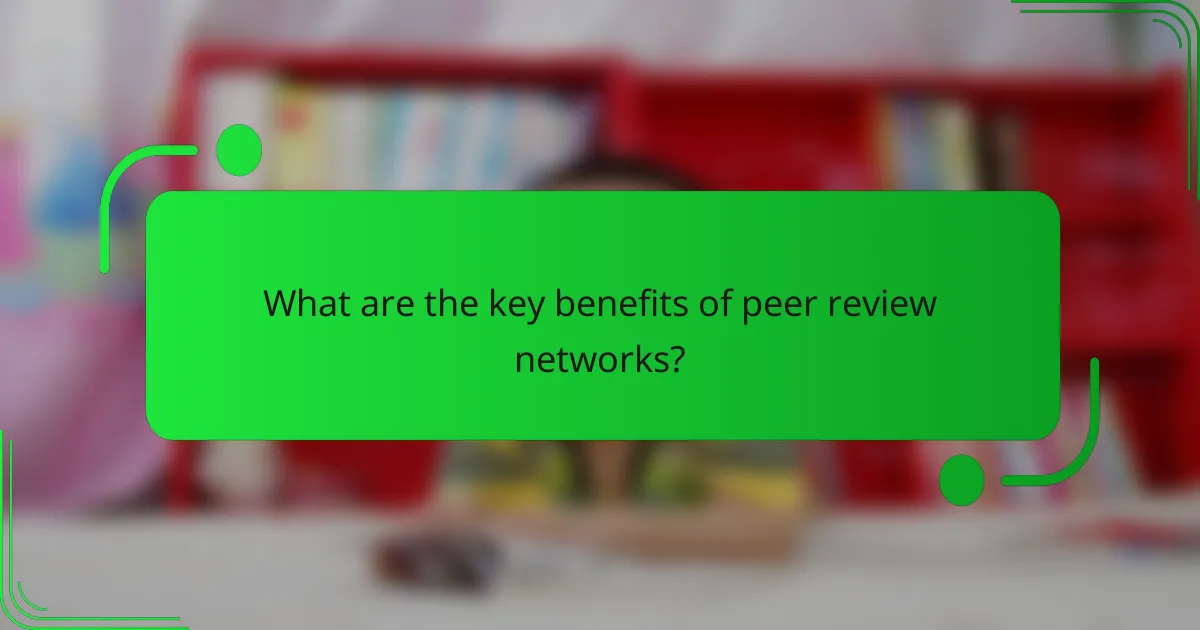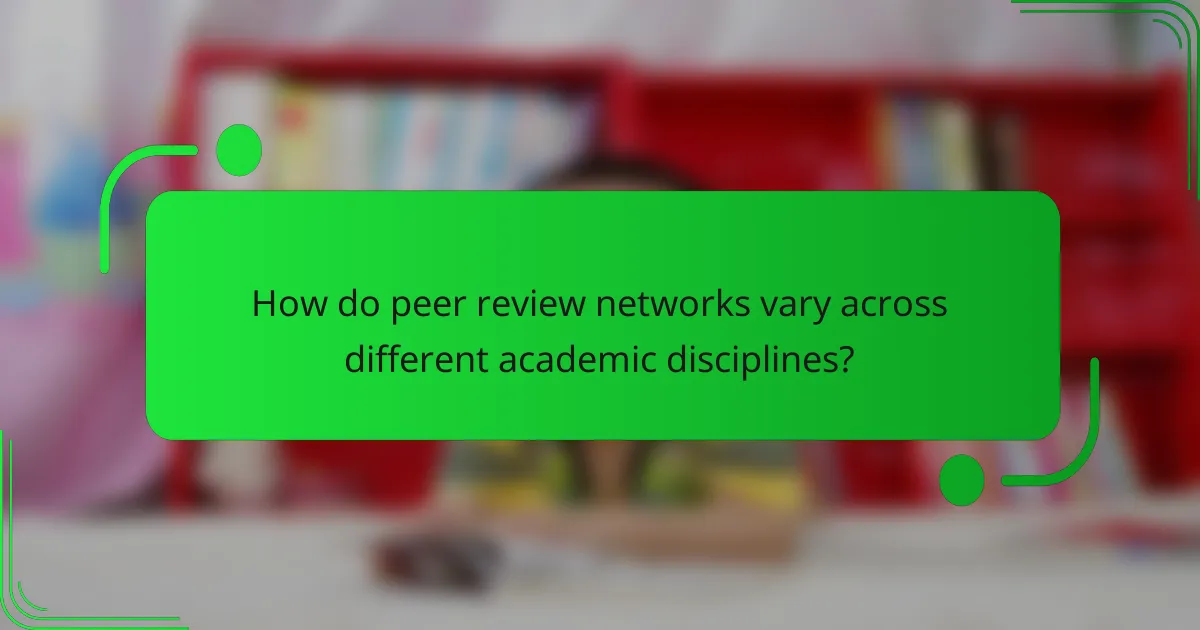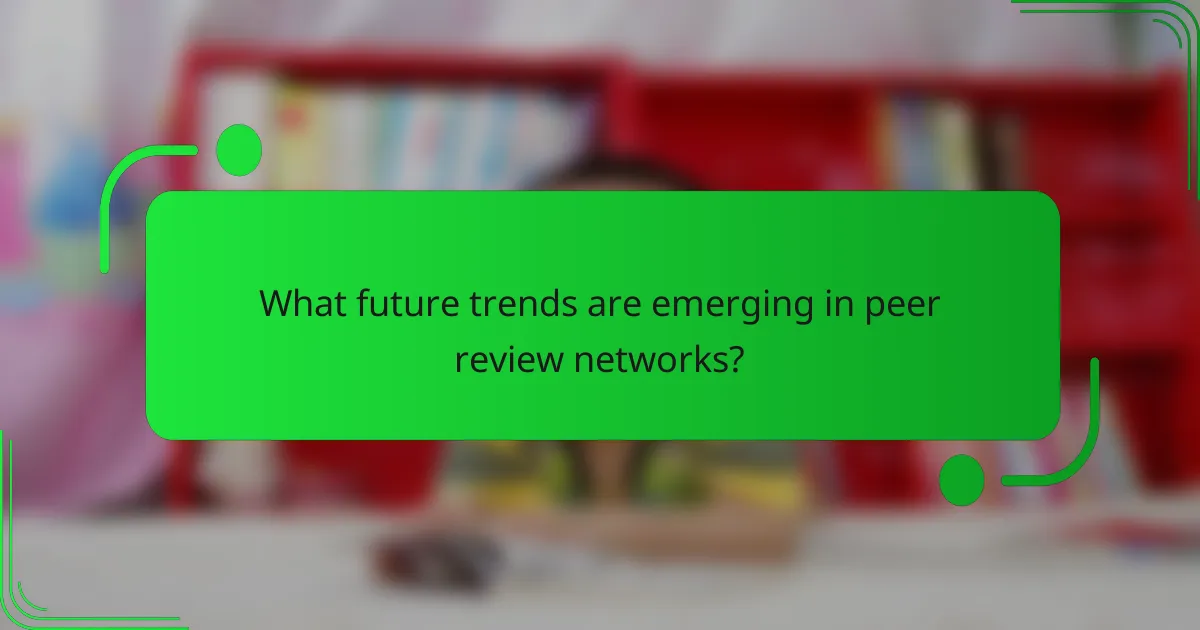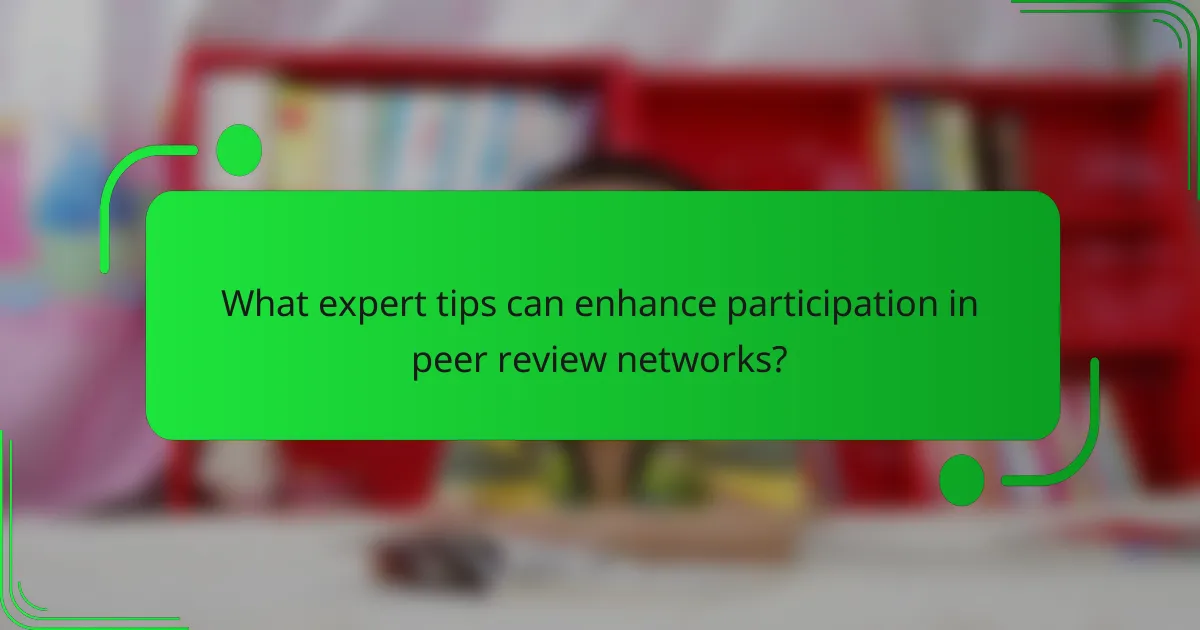Peer review networks significantly enhance research quality and academic credibility. This article explores the benefits of these networks, outlines their key processes, and highlights best practices for effective engagement. It also addresses challenges and emerging trends that shape peer review across various disciplines. Understanding these elements is crucial for researchers aiming to improve their publication outcomes.

What are the key benefits of peer review networks?
Peer review networks enhance research quality, foster collaboration, and improve academic credibility. They provide structured feedback, ensuring rigorous evaluation of work. Additionally, these networks facilitate networking opportunities, connecting researchers across disciplines. As a result, they contribute to the advancement of knowledge and innovation.
How do peer review networks enhance research quality?
Peer review networks significantly enhance research quality by ensuring rigorous evaluation and constructive feedback. They facilitate collaboration among experts, promote transparency, and uphold academic integrity. This process leads to more reliable and validated research outcomes, ultimately benefiting the scientific community. By including diverse perspectives, these networks improve the overall robustness of research findings.
What role do peer review networks play in academic credibility?
Peer review networks enhance academic credibility by providing rigorous evaluation of research. They ensure that scholarly work meets quality standards through expert feedback. This process fosters trust among researchers and the public, validating findings and promoting knowledge dissemination. Additionally, peer review networks create a collaborative environment, encouraging innovation and improvement in research methodologies.
Which benefits do authors experience through peer review networks?
Authors experience numerous benefits through peer review networks, including enhanced credibility, constructive feedback, and broader visibility for their work. These networks facilitate connections with other scholars, fostering collaboration and knowledge sharing. Additionally, authors can refine their research skills and gain insights into industry standards through the review process. Ultimately, participation in these networks contributes to professional growth and improved publication outcomes.
How do peer review networks support collaboration among researchers?
Peer review networks enhance collaboration among researchers by facilitating feedback and knowledge exchange. They connect scholars from diverse fields, fostering interdisciplinary dialogue. These networks streamline the review process, allowing for quicker publication timelines and improved research quality. Additionally, they build professional relationships, which can lead to future collaborations and joint projects.

What processes are involved in peer review networks?
Peer review networks involve several key processes that ensure the integrity and quality of scholarly work. These processes typically include manuscript submission, editorial assessment, peer reviewer selection, reviewer evaluation, and final decision-making.
During manuscript submission, authors submit their work to a journal, where it undergoes an initial editorial review. The editorial team then selects appropriate peer reviewers based on their expertise. Reviewers evaluate the manuscript for quality, originality, and relevance, providing feedback and recommendations. The editor considers these evaluations to make a final decision on publication, often involving revisions based on reviewer comments.
This structured approach enhances the credibility of published research and fosters collaboration among scholars.
How does the peer review submission process work?
The peer review submission process involves several key steps: authors submit manuscripts, editors assess submissions, reviewers evaluate content, and decisions are communicated. This process ensures quality and integrity in academic publishing. Authors typically submit their work through an online platform, where initial checks for relevance and formatting occur. Reviewers, selected for their expertise, provide feedback and recommendations. After revisions, the editor makes a final decision on publication. This structured approach enhances the credibility of research findings.
What criteria are used for selecting reviewers in peer review networks?
Reviewers in peer review networks are selected based on their expertise, publication history, and relevance to the manuscript topic. The criteria ensure that reviewers possess a deep understanding of the subject matter, which enhances the quality of the review process. Additionally, factors such as impartiality and the ability to meet deadlines are considered. This selection process aims to maintain rigorous academic standards and foster constructive feedback for authors.
How is feedback provided to authors during the peer review process?
Feedback is provided to authors during the peer review process through structured comments from reviewers. Reviewers evaluate the manuscript’s quality, methodology, and relevance. They provide constructive criticism aimed at enhancing the work. Authors receive detailed insights on strengths and weaknesses, helping them improve their submissions. This iterative process fosters academic rigor and collaboration.
What are the different models of peer review in practice?
Peer review models vary widely, each offering distinct benefits and processes. Common models include traditional peer review, open peer review, and post-publication peer review.
Traditional peer review involves anonymous reviewers evaluating submissions before publication. This model enhances objectivity but may lack transparency. Open peer review allows for public visibility of both reviewers and their comments, promoting accountability and constructive feedback. Post-publication peer review occurs after articles are published, enabling ongoing critique and updates, fostering a dynamic scholarly discourse.
Each model has unique attributes that cater to different academic needs and preferences, thus shaping the landscape of scholarly communication.

What best practices should be followed in peer review networks?
To ensure effective peer review networks, follow these best practices: establish clear guidelines, maintain transparency, encourage constructive feedback, and foster a collaborative environment. These principles enhance the review process and improve outcomes.
1. Establish clear guidelines: Define expectations for reviewers and authors to ensure consistency and quality.
2. Maintain transparency: Share the review process and decisions openly to build trust among participants.
3. Encourage constructive feedback: Focus on providing actionable suggestions rather than just criticism.
4. Foster a collaborative environment: Promote open communication and support among reviewers and authors for better engagement.
How can researchers effectively engage with peer review networks?
Researchers can effectively engage with peer review networks by actively participating, providing constructive feedback, and networking with peers. Building relationships within these networks enhances collaboration and improves the quality of research.
Engagement strategies include:
1. **Active Participation**: Regularly review submissions and contribute to discussions.
2. **Constructive Feedback**: Offer detailed, actionable insights to improve submitted work.
3. **Networking**: Connect with other researchers to foster collaborations and share knowledge.
4. **Utilizing Platforms**: Use established platforms or forums dedicated to peer review to stay informed and engaged.
These practices not only benefit individual researchers but also strengthen the overall integrity of the research community.
What strategies improve the peer review experience for authors and reviewers?
Implementing structured peer review processes enhances the experience for both authors and reviewers. Establishing clear guidelines and expectations fosters better communication.
Regular training sessions for reviewers improve their evaluation skills, ensuring constructive feedback. Utilizing technology platforms streamlines submissions and tracking, reducing administrative burdens.
Encouraging open dialogue between authors and reviewers can lead to more meaningful exchanges and improved revisions. Lastly, recognizing and rewarding reviewers can increase motivation and engagement in the peer review process.
Which common pitfalls should be avoided in peer review processes?
To avoid common pitfalls in peer review processes, ensure clear communication and adherence to guidelines. Prioritize timely feedback, maintain objectivity, and avoid conflicts of interest. Additionally, ensure reviewers are adequately qualified and understand their roles. Lastly, foster an environment for constructive criticism to improve the quality of submissions.

What are the challenges faced by peer review networks?
Peer review networks face challenges such as bias, lack of transparency, and inconsistent quality. These issues can undermine the credibility of the review process. For example, personal relationships may influence reviewer objectivity, leading to favoritism. Additionally, the anonymity of reviewers can create a lack of accountability, which may result in poor feedback quality. Lastly, varying standards across different fields can complicate the evaluation process, making it difficult to maintain uniformity in reviews.
How do peer review networks address issues of bias and fairness?
Peer review networks address bias and fairness by implementing structured processes and diverse reviewer pools. They promote transparency in evaluation criteria, ensuring that all submissions receive equitable treatment. By utilizing double-blind reviews, these networks minimize potential biases related to author identity. Furthermore, ongoing training for reviewers on recognizing and mitigating bias enhances the fairness of the review process.
What impact does the speed of the peer review process have on research dissemination?
The speed of the peer review process significantly affects research dissemination. A faster review can lead to quicker publication, enhancing visibility and impact. Delays may hinder timely access to findings, affecting the relevance of research in rapidly evolving fields. Efficient peer review networks can streamline this process, ensuring that critical research reaches the audience without unnecessary wait times. As a result, the overall pace of scientific communication improves, fostering collaboration and innovation.

How do peer review networks vary across different academic disciplines?
Peer review networks vary significantly across academic disciplines, reflecting their unique practices and standards. In the sciences, peer review is often rigorous and anonymous, emphasizing reproducibility and data transparency. In contrast, humanities disciplines may favor an open review process, valuing critical discourse and interpretation over strict empirical validation. Social sciences often blend these approaches, incorporating both quantitative and qualitative evaluations. Each discipline’s peer review network is shaped by its core values, influencing publication speed, reviewer selection, and feedback mechanisms.
Which unique attributes are found in peer review networks for STEM fields?
Peer review networks in STEM fields exhibit unique attributes such as interdisciplinary collaboration, diverse reviewer expertise, and enhanced transparency. These attributes foster rigorous evaluation and improve research quality. Additionally, they often incorporate innovative technologies for efficient communication and feedback.
How do social sciences approach peer review differently?
Social sciences often emphasize collaborative peer review processes that involve diverse perspectives. This approach enhances the quality and relevance of research by incorporating interdisciplinary insights. Social sciences may prioritize community engagement, valuing feedback from practitioners alongside academic peers. This contrasts with more traditional fields that focus primarily on expert evaluations. Additionally, social sciences frequently adopt transparent review processes, fostering trust and accountability among stakeholders.

What future trends are emerging in peer review networks?
Emerging trends in peer review networks focus on transparency, collaboration, and technology integration. These trends enhance the efficiency and credibility of the peer review process. Increased use of artificial intelligence for manuscript evaluation is notable, as it streamlines reviewer selection and improves feedback quality. Additionally, open peer review models are gaining traction, promoting accountability and reducing bias. Crowdsourced reviews are also emerging, enabling broader participation and diverse perspectives in the evaluation process. Finally, blockchain technology is being explored to ensure the integrity of reviews and maintain an immutable record of contributions.
How is technology transforming peer review processes in 2025?
Technology is revolutionizing peer review processes by enhancing efficiency, transparency, and collaboration. Advanced algorithms streamline submissions, while digital platforms facilitate real-time feedback and communication among reviewers.
Artificial intelligence tools assist in identifying potential reviewers and detecting plagiarism, ensuring a more rigorous evaluation. Additionally, blockchain technology offers secure tracking of submissions and revisions, fostering trust in the integrity of the review process.
Data analytics enables journals to assess reviewer performance and publication trends, optimizing future peer review practices. As a result, these technological advancements are shaping a more effective and credible peer review landscape.
What role will open peer review play in the evolution of research networks?
Open peer review will enhance transparency and collaboration in research networks. It fosters trust by allowing community feedback during the review process, which can lead to more robust findings. This approach encourages diverse perspectives, improving the quality and credibility of research outputs. Additionally, open peer review can expedite the publication process, as it reduces the time spent in traditional, closed review cycles. By involving a broader audience, it democratizes knowledge sharing and supports a more inclusive research culture.
How can peer review networks adapt to changing academic landscapes?
Peer review networks can adapt by embracing digital tools, enhancing collaboration, and prioritizing transparency. These changes allow for efficient evaluations and diverse perspectives in the academic landscape. Adopting open peer review practices fosters trust and accountability among researchers. Additionally, integrating artificial intelligence can streamline the review process, ensuring timely feedback while maintaining quality standards. By focusing on community engagement, peer review networks can remain relevant and responsive to evolving academic demands.

What expert tips can enhance participation in peer review networks?
Engaging effectively in peer review networks requires strategic actions. Foster relationships by actively participating in discussions and providing constructive feedback. Establish a reputation for reliability by consistently meeting deadlines and adhering to guidelines. Leverage social media and academic platforms to broaden your network. Additionally, consider joining specialized groups to connect with like-minded professionals.
How to build a strong profile as a reviewer in peer review networks?
To build a strong profile as a reviewer in peer review networks, focus on establishing credibility and showcasing expertise. Start by consistently providing high-quality, constructive feedback, which enhances your reputation. Engage actively in relevant academic communities to increase visibility and network with other scholars.
Next, maintain a comprehensive profile that highlights your research interests, publications, and experience. Regularly update your profile with new achievements and contributions. Consider obtaining endorsements from colleagues to further validate your expertise.
Lastly, participate in workshops or training sessions on peer review best practices to enhance your skills and stay current with industry standards. This commitment will position you as a reliable and knowledgeable reviewer in peer review networks.
What are effective ways to provide constructive feedback as a reviewer?
Effective ways to provide constructive feedback as a reviewer include being specific, balanced, and timely. Focus on clear examples to illustrate points and offer actionable suggestions for improvement.
1. Start with positive feedback to create a supportive atmosphere.
2. Use specific examples to clarify your points and avoid vague statements.
3. Balance criticism with praise to maintain motivation.
4. Offer practical suggestions for improvement to guide the recipient.
5. Ensure feedback is timely, addressing issues while they are still relevant.
6. Encourage open dialogue to foster understanding and collaboration.
Which resources can help researchers navigate peer review networks successfully?
Researchers can effectively navigate peer review networks by utilizing specific resources. Key resources include academic journals, online platforms like ResearchGate or Academia.edu, and institutional support services. These platforms provide access to peer networks, facilitate communication with reviewers, and offer guidance on the submission process. Additionally, mentorship from experienced colleagues can enhance understanding of best practices in peer review. Networking events and conferences also serve as valuable opportunities to connect with peers and gain insights into successful navigation of these networks.



